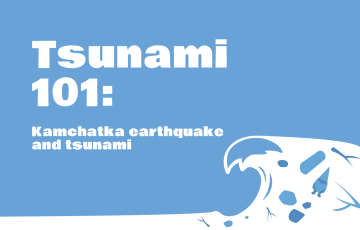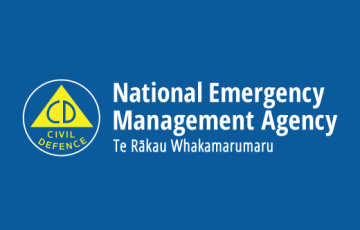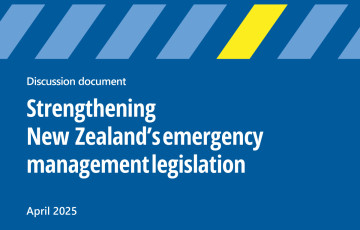CDEM Award winners announced
CDEM Award winners were announced at the Ministerial Awards and Conference Dinner on Wednesday 1 June.
CDEM Silver Award: for important contributions to CDEM in New Zealand
Lee Hazlewood
Lee Hazlewood has made an invaluable and lasting impression on the CDEM sector through his establishment and leadership of the successful Integrated Training Framework. Prior to the establishment of the Integrated Training Framework, training of New Zealand CDEM staff had been predominantly ad-hoc with no national standardisation or direction, being left to individual CDEM Groups and Territorial Authorities.
In 2012, Lee identified the need for standardised and integrated training of CDEM staff in the Waikato CDEM group to both improve the standard of training for individual staff, and to improve the interoperability of emergency operations centre staff across boundaries. Lee took the initiative to engage with neighbouring CDEM groups, and it soon became apparent that this was a common challenge faced by all.
Lee set up the Integrated Training Framework with the establishment of a steering group aimed to develop a collaborative approach to drive the standardised development and implementation of training. Lee chaired the steering group committee and continues to do so today.
Lee has put in a tremendous effort to pull together resources from across many CDEM groups, resolving differences of opinion and facilitating improved collaboration and the identification of common approaches. The process has taken a considerable amount of time which has meant that Lee has had to juggle the work of his CDEM roles and responsibilities, often at the personal sacrifice of time with his family. The Integrated Training Framework is an example of the way progress can be made when effort and resources are combined with committed support
While the Integrated Training Framework has been a success due to the contributions of all stakeholders, it would not have achieved what it has without Lee’s dedication, commitment, and drive.
David Johnston
David Johnston has made an outstanding and sustained contribution to emergency management over the past 25 years.
David was a key New Zealand contributor to the five year effort that culminated in the third World Conference on Disaster Risk Reduction in March 2015 in Sendai, Japan and the follow-up New Zealand Symposium on Disaster Risk Reduction held at Te Papa, Wellington on 15 June 2015.
Linked to the Sendai process, David initiated the new Integrated Research on Disaster Risk International Centre of Excellence in Community Resilience in order to examine how communities make themselves resilient to future disasters. The benefits of the International Centre of Excellence include opportunities to highlight New Zealand research within this international network, directly inform and contribute to best practice in the Wellington Region, and help build and integrate capacity across New Zealand.
This work sits alongside 25 years of involvement in emergency management in New Zealand. David has led a range of research, training, capacity building and continuing professional development initiatives. David’s roles include Theme Leader within the Natural Hazards Research Platform, Director of the Joint Centre for Disaster Research and Chair of Massey University’s Emergency Management Programme Board of Studies. David has mentored GNS and Massey staff, coordinated postgraduate papers in emergency management and supervised postgraduate students. This work is complemented by his international work as Chair of the Scientific Committee of Integrated Research on Disaster Risk from 2012-2015 and as a member of the UN International Strategy for Disaster Reduction Scientific and Technical Advisory Group from 2013-2016.
David has authored or co-authored 136 articles for leading peer-reviewed journals, co-authored over 25 book chapters and over 65 science reports. David’s scholar-practitioner reputation and peer recognition is reflected in invitations to provide expert advice to key international organisations, play leadership roles in international research initiatives and deliver keynote addresses at major national and international conferences. David’s work in the emergency management community has been, and will continue to be, immensely influential throughout New Zealand and abroad.
Murray Sinclair
Murray Sinclair has been a pivotal player in Canterbury CDEM over the last two decades, particularly in the wake of the 2010 earthquakes.
In 1996 Murray was assigned responsibility for disaster management planning for Christchurch City Council and, following a review of CDEM arrangements, was appointed as the Unit Manager, Civil Defence and Emergency Management.
Murray was the Emergency Operations Centre Response Manager during the response to the September 2010 and February 2011 earthquakes. Murray supported Christchurch City Council staff and volunteers during this challenging time and his steadfastness, dedication, guidance and compassion during this time is an enduring memory for his team.
Murray has been a passionate supporter of CDEM volunteers. This was evidenced by the large number of volunteers in Christchurch, particularly in Welfare and Response Teams, and the significant role these volunteers undertook during the 2010 and 2011 earthquakes.
A dedicated advocate for CDEM, Murray has encouraged a culture of continuous improvement. He has actioned recommendations from the Review of the Earthquake Response and the MCDEM monitoring and evaluation programme to ensure Christchurch continues to model best practice.
Murray has represented Christchurch City Council throughout the planning for the Christchurch Justice and Emergency Services Precinct. This project is one of the Government’s anchor projects in the city and is significant in the recovery landscape. Working with numerous stakeholders, Murray has ensured the Christchurch Justice and Emergency Services Precinct has paved the way for improved coordination and collaboration between agencies, during both business and usual and response.
Murray has tirelessly encouraged risk reduction, readiness, response and recovery activities during his tenure. He has been a wealth of information and advice for Christchurch City Council and others in the region, and has willingly shared his expertise nationally and internationally.
Without Murray’s leadership Christchurch would be less safe and its people less prepared.
Director’s Award for Innovation: for exceptional innovation or creativity that has pushed the boundaries of current CDEM practice in New Zealand
David Askin
Following the February 2011 earthquakes, David saw a need for communities to be better connected, organised and prepared to help themselves and each other. David created the Gets Ready software and the Selwyn Gets Ready website. The website allows users to securely record their household contact details and any special needs, resources and skills they have and are willing to share during an emergency.
David’s local community, Darfield, embraced the system with hundreds of households signing up. Selwyn District Council recognised the value of David’s website and decided to promote it across the District. There are now over 5,900 households signed up to Selwyn Gets Ready, that’s around a third of all households in the District.
Selwyn District Council’s Civil Defence Emergency Management team find Selwyn Gets Ready is an invaluable tool to alert Selwyn residents to important information that will directly affect them. Situation reports from the community can be sent to Selwyn District Council via the website or the mobile app. This empowers communities to take care of themselves, while providing tools to request help should they need it.
Selwyn Gets Ready was the dream of one community minded man with a vision to help his community become better prepared and connected. With the help of his community, David has realised that dream. It fits with the New Zealand system of emergency management in that it allows communities to be involved in the emergency management process and it contributes significantly to community readiness, response and recovery.
Firth
RibRaft TC3 was conceptualised on a paper napkin on a flight following a visit to Christchurch in the wake of the devastating 2011 earthquakes. Realising the idea had real practical appeal, Jon Hambling, Dene Cook, Andrew Moss and Dominic Sutton further developed the concept of an adjustable residential concrete flooring system. Whilst the first project was cast in Christchurch, the RibRaft TC3 system is now being used nationwide on thousands of projects.
This fully re-levelable twin slab flooring system is a world first. In the event of a house settling following a strong earthquake, it can readily be re-levelled without removing cladding or internal walls. The double slab system is stiff and easily resists deformations induced by post-earthquake settlement. The RibRaft TC3 therefore reduces the risk of earthquake damage and reduces the impact of a disaster on the home occupants by providing resilience. In case of excessive settlements the upper slab contains cast-in jacks that can be accessed with minimal disruption to the home owners. The ability to relevel a home quickly and without the need for intrusive and prolonged measures enables rapid emergency response and recovery.
RibRaft TC3 enables homeowners to quickly and readily repair significant damage and continue to live in their home following an emergency. This innovative solution gives effect, in an evolutionary way, to civil defence emergency management principles supporting families to stay in their home environment.
The Firth RibRaft TC3 solution provides an excellent and truly innovative building platform that will enable families to continue to occupy their homes, and quickly and cheaply repair significant earthquake damage.
Published: Jun 2, 2016, 8:34 AM



